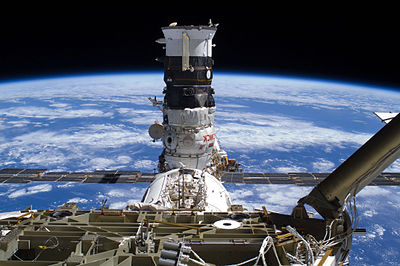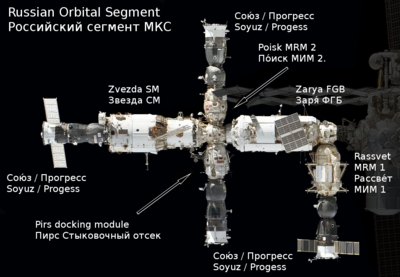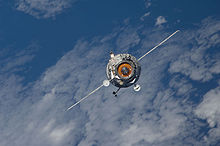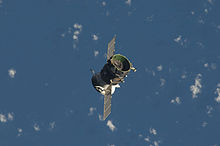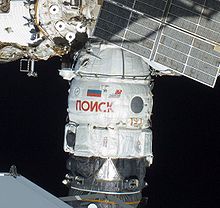- Poisk (ISS module)
-
Poisk (Russian: По́иск; lit. Search), also known as the Mini-Research Module 2 (MRM 2), Малый исследовательский модуль 2, or МИМ 2, is a docking module of the International Space Station. Its original name was Docking Module 2 (Stykovochniy Otsek 2 (SO-2)), as it is almost identical to the Pirs Docking Compartment. Poisk was the first major Russian addition to the International Space Station since 2001.[1]
Contents
Details
Poisk docked to the zenith port of the Zvezda module on November 12, 2009, and will serve as an additional docking port for Soyuz and Progress spacecraft and as an airlock for spacewalks. Poisk will also provide extra space for scientific experiments, and provide power-supply outlets and data-transmission interfaces for two external scientific payloads to be developed by the Russian Academy of Sciences.
Two spacewalks conducted from the ISS in June 2009, successfully completed activities anticipating Poisk module's future berthing.
On 5 June 2009, during Russian Orlan EVA-22 spacewalk[2] Expedition 19/20 Commander Gennady Padalka and Flight Engineer Michael Barratt installed two Kurs docking antennas, a docking target and electrical connectors on the exterior of Zvezda's Service Module.
On June 10, 2009, during Russian Orlan EVA-23 spacewalk[3] Padalka and Barratt replaced a flat hatch cover in the forward section of Zvezda with a standard conical docking cone cover to allow for Poisk's docking.
On January 14, 2010, cosmonauts Oleg Kotov and Maksim Suraev conducted a spacewalk to outfit the Poisk module to prepare for receiving Soyuz and Progress ships in the future[4]. They deployed antennas and a docking target, installed two handrails and plugged the new module's Kurs antennas into the Kurs docking system circuitry[5]. The spacewalk lasted five hours and 44 minutes.
On January 21, 2010, the module was first used when cosmonaut Suraev and Expedition 22 Commander Jefferey Williams relocated their Soyuz TMA-16 spacecraft from the aft port of the Zvezda module to the zenith-facing port of the Poisk module[6]. The Soyuz TMA-16 spacecraft undocked from the aft end of the Zvezda service module at 10:03 UTC and backed away to a distance of about 100 feet from the space station. Undocking occurred as the station flew about 213 miles high off the southwest coast of Africa. Re-docking occurred at 10:24 UTC after Suraev fired the Soyuz maneuvering thrusters to fly halfway around the orbiting space station and line up with the Poisk module.
Design and construction
The module was designed and built by S.P. Korolev RSC Energia[7][8][9], the leading organization engaged in the development and operational use of the ISS Russian segment.
Launch in 2009
The module was launched on November 10, 2009, 2:22 p.m. GMT[10][11] attached to a modified Progress spacecraft, called Progress M-MIM2, on a Soyuz-U rocket from Launch Pad 1 at the Baikonur Cosmodrome in Kazakhstan. The occasion also marked the 1750th launch of a Soyuz rocket in its various configurations.[12] About eight minutes after launch, the three-stage Soyuz rocket delivered Poisk, to a low-altitude injection orbit. According to NASA Poisk carried about 1800 pounds of cargo to the ISS including new Russian Orlan spacesuits, life support equipment, medical supplies and crew hygiene items.
The Progress space tug provided electrical power and propulsion for the Poisk module during its two-day journey to the space station. On 12 November, Progress began its automated final approach to the station on a Kurs rendezvous radar system and at 15:41 UTC[13] Poisk docked to the Zvezda module's zenith port. The docking happened as the space station sailed more than 220 miles over northern Kazakhstan.
Cosmonauts Maksim Suraev and Roman Romanenko entered the module for the first time by opening the hatch leading into Poisk at 12:17 UTC on 13 November 2009.
The jettisoning of the Progress ship from the Poisk module happened around 8 December 2009. The Progress was destroyed during re-entry into the atmosphere.
Specifications
Designation[14] 240GK No. 2L Launch mass 3670 kg ± 50 kg Maximum hull diameter 2.55 m Hull length between docking assembly planes 4.049 m Pressurized volume 14.8 m3 Habitable volume 10.7 m3 Number of egress hatches (open inward) 2 Egress hatch diameter 1 m Mass of delivered cargoes up to 1000 kg False depressurization alarm
False alarms woke the crews aboard space shuttle Atlantis and the Space Station at 01:36 UTC on 20 November 2009 and once again at 02:53 UTC on 21 November.[15][16] An erroneous indication of a rapid depressurization led to the automatic shutdown of ventilation fans throughout the station, which stirred up dust and led to a false smoke detection alarm in the European Space Agency's Columbus laboratory. Mission control Capcom Frank Lien in Houston told Expedition 21 Commander Frank De Winne it might have originated with the Poisk module.
Visited spacecraft
The following Table shows the spacecraft that have linked up with the Poisk Module
Spacecraft Docking Undocking Soyuz TMA-16 January 21, 2010
5:24 a.m. ESTMarch 18, 2010
8:03 UTCSoyuz TMA-18 April 4, 2010
5:25 UTCSeptember 25, 2010
02:02 UTCSoyuz TMA-01M October 10, 2010
00:01 UTCMarch 16, 2011
PlannedGallery
See also
- Scientific research on the ISS
- Rassvet (ISS module)
- Russian Orbital Segment
References
- ^ "Docking Compartment-1 and 2". http://www.russianspaceweb.com/iss_dc.html. Retrieved 2009-03-26.
- ^ NASA (5 June 2009). "ISS On-Orbit Status 06/05/09". http://www.nasa.gov/directorates/somd/reports/iss_reports/2009/06052009.html. Retrieved 11 November 2009.
- ^ NASA (10 June 2009). "ISS On-Orbit Status 06/10/09". http://www.nasa.gov/directorates/somd/reports/iss_reports/2009/06102009.html. Retrieved 11 November 2009.
- ^ NASA (14 January 2010). "Station Crew Completes First Expedition 22 Spacewalk". http://www.nasa.gov/mission_pages/station/expeditions/expedition22/exp22_eva.html. Retrieved 16 January 2010.
- ^ NASA (January 14, 2010). "ISS On-Orbit Status 01/14/10". http://www.nasa.gov/directorates/somd/reports/iss_reports/2010/01142010.html. Retrieved January 16, 2010.
- ^ Stephen Clark (January 21, 2010). "Crew shifts Soyuz capsule to new station docking port". Spaceflightnow.com. http://www.spaceflightnow.com/station/exp22/100121soyuz/. Retrieved January 21, 2010.
- ^ "International Space Station". RSC Energia. June 16–17, 2009. http://www.energia.ru/eng/iss/iss22/photo_06-16.html.
- ^ NASA. "New Russian Module "Poisk" On Its Way to Station". http://www.nasa.gov/mission_pages/station/main/index.html. Retrieved 11 November 2009.
- ^ "FAWG Planning Manifest" (Press release). NASA/NASASpaceflight.com. 2008-11-17.
- ^ "August 28, 2009. S.P.Korolev RSC Energia, Korolev, Moscow region". RSC Energia. 2009-08-28. http://www.energia.ru/eng/iss/mim1/photo_08-28.html. Retrieved 2009-09-03.
- ^ Stephen Clark (10 November 2009). "Poisk launches to add new room for space station". spaceflightnow.com. http://www.spaceflightnow.com/station/exp21/091110mrmlaunch/. Retrieved 11 November 2009.
- ^ "Success of the 1750th launch of Soyuz". STARSEM The Soyuz Company. November 10, 2009. http://www.starsem.com/news/releases.htm#1750. Retrieved May 10, 2010.
- ^ New Russian module docks to station
- ^ William Harwood (19 November). "Crews awakened by false fire, depressurization alarms". http://spaceflightnow.com/shuttle/sts129/091119fd4/index3.html. Retrieved 20 November 2009.
- ^ William Harwood (20 November 2009). "Astronauts awakened a second night by false alarms". spaceflightnow.com. http://spaceflightnow.com/shuttle/sts129/091120fd5/index2.html. Retrieved 21 November 2009.
Components of the International Space Station Overview Assembly · US Orbital Segment · Russian Orbital Segment · Expeditions · Spacewalks · ISS Program · Scientific Research · Major Incidents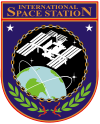
Major components
in orbitZarya (Functional Cargo Block) · Zvezda (Service Module) · Unity (Node 1) · Harmony (Node 2) · Tranquility (Node 3) · Destiny (Laboratory) · Columbus (Laboratory) · Kibō (PM, ELM-PS, EF) · Quest (Airlock) · Pirs (Airlock / Docking Module) · Rassvet (MRM 1) · Poisk (MRM 2) · Leonardo (PMM) · Cupola · Integrated Truss Structure (ITS)Subsystems
in orbitFlight-ready hardware
with no launch planScheduled for launch
by ProtonProposed module Cancelled Support vehicles Current: Soyuz · Progress · Automated Transfer Vehicle (ATV) · H-II Transfer Vehicle (HTV)
Future: Dragon · Cygnus · Orion · Rus · CST-100
Former: Space ShuttleMission control centers ← 2008 · Orbital launches in 2009 · 2010 → USA-202 | Ibuki · SDS-1 · Sohla-1 · Raijin · Kagayaki · Hitomi · Kukai · Kiseki | Koronas-Foton | Omid | NOAA-19 | Progress M-66 | Ekspress-AM44 · Ekspress-MD1 | Hot Bird 10 · NSS-9 · Spirale-A · Spirale-B | OCO | Telstar 11N | Raduga-1 | Kepler | STS-119 (ITS S6) | GOCE | USA-203 | Soyuz TMA-14 | Eutelsat W2A | USA-204 | Kwangmyŏngsŏng-2 | Compass-G2 | RISAT-2 · ANUSAT | Sicral-1B | Yaogan 6 | Kosmos 2450 | USA-205 | Progress M-02M | STS-125 | Herschel · Planck | ProtoStar II | TacSat-3 · PharmaSat · AeroCube 3 · HawkSat I · CP-6 | Meridian 2 | Soyuz TMA-15 | LRO · LCROSS | MEASAT-3a | GOES 14 | Sirius FM-5 | TerreStar-1 | Kosmos 2451 · Kosmos 2452 · Kosmos 2453 | RazakSAT | STS-127 (JEM-EF · AggieSat 2 · BEVO-1 · Castor · Pollux) | Kosmos 2454 · Sterkh-1 | Progress M-67 | DubaiSat-1 · Deimos-1 · UK-DMC 2 · Nanosat 1B · AprizeSat-3 · AprizeSat-4 | AsiaSat 5 | USA-206 | JCSAT-RA · Optus D3 | STSAT-2A | STS-128 (Leonardo MPLM) | Palapa-D | USA-207 | HTV-1 | Meteor M-1 · Universitetsky-Tatyana-2 · Sterkh-2 · UGATUSAT · BLITS · SumbandilaSat · IRIS | Nimiq 5 | Oceansat-2 · BeeSat-1 · UWE-2 · ITU-pSat1 · SwissCube-1 · Rubin 9.1 · Rubin 9.2 | USA-208 · USA-209 | Soyuz TMA-16 | Amazonas-2 · COMSATBw-1 | WorldView-2 | Progress M-03M | USA-210 | Thor-6 · NSS-12 | SMOS · Proba-2 | Progress M-MIM2 (Poisk) | Shijian XI-01 | STS-129 (ExPRESS-1 · ExPRESS-2) | Kosmos 2455 | Intelsat 14 | Eutelsat W7 | IGS Optical 3 | Intelsat 15 | USA-211 | Yaogan 7 | Kosmos 2456 · Kosmos 2457 · Kosmos 2458 | Yaogan 8 · Xi Wang 1 | Helios IIB | Soyuz TMA-17 | DirecTV-12Payloads are separated by bullets ( · ), launches by pipes ( | ). Manned flights are indicated in bold text. Uncatalogued launch failures are listed in italics. Payloads deployed from other spacecraft are denoted in brackets.Categories:- Components of the International Space Station
- Russian components of the International Space Station
- 2009 in spaceflight
Wikimedia Foundation. 2010.

